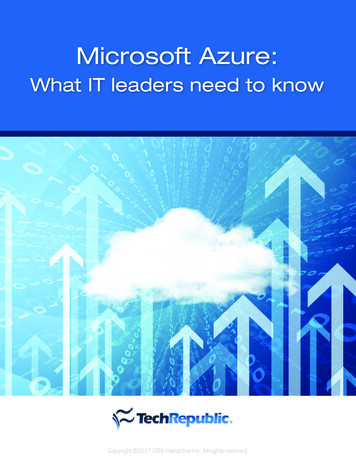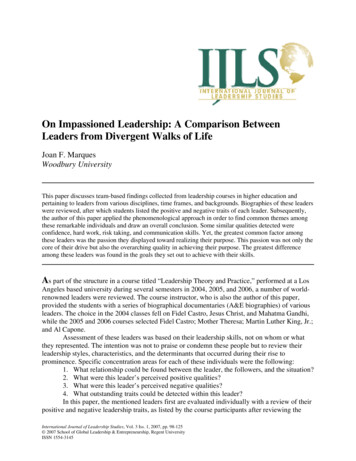
Transcription
Microsoft Azure:What IT leaders need to knowCopyright 2017 CBS Interactive Inc. All rights reserved.
2MICROSOFT AZURE: WHAT IT LEADERS NEED TO KNOWMicrosoft Azure:What IT leaders needto knowCopyright 2017 by CBS Interactive Inc. All rightsreserved. TechRepublic and its logo are trademarksof CBS Interactive Inc. All other product names orservices identified throughout this book are trademarks or registered trademarks of their respectivecompanies. Reproduction of this publication in anyCREDITSGlobal Editor in ChiefJason HinerEditor in Chief, UKSteve Rangerform without prior written permission is forbidden.Managing EditorBill DetwilerPublished by TechRepublicEditor, AustraliaChris DuckettAugust 2017DisclaimerThe information contained herein has been obtainedfrom sources believed to be reliable. CBS InteractiveInc. disclaims all warranties as to the accuracy,completeness, or adequacy of such information.CBS Interactive Inc. shall have no liability for errors,omissions, or inadequacies in the informationcontained herein or for the interpretations thereof.The reader assumes sole responsibility for theselection of these materials to achieve its intendedresults. The opinions expressed herein are subject tochange without notice.Senior Features EditorsJody GilbertMary WeilageSenior EditorConner ForrestSenior WritersDan PattersonTeena MaddoxChief ReporterNick HeathStaff WritersAlison DeNiscoBrandon VigliaroloAssociate EditorAmy TalbottTechRepublic9920 Corporate Campus Dr.Suite 1000Louisville, KY 40223Online Customer a Producer/EditorDerek PooreAssociate Social Media EditorLeah BrownCover art: iStock/cherezoffCopyright 2017 CBS Interactive Inc. All rights reserved.
3MICROSOFT AZURE: WHAT IT LEADERS NEED TO KNOWContents04Microsoft Azure: What it is, why it matters10Use the free Azure price calculator to determine what services willcost before you sign up12Microsoft’s biggest Azure feat? Getting its partner community onboard with the cloud14Microsoft launches Azure Container Instances to easily bringLinux containers to the cloud16Microsoft improves Azure’s analytical capabilities with Cloudynacquisition18AWS Snowball Edge vs. Azure Stack: What on-premises publiccloud means for your data center20Cycle Computing will make Microsoft Azure more appealing tomore enterprises22Microsoft Azure Cosmos DB: A turnkey database system forbusiness26About TechRepublicCopyright 2017 CBS Interactive Inc. All rights reserved.
4MICROSOFT AZURE: WHAT IT LEADERS NEED TO KNOWMicrosoft Azure: What it is, why itmattersBy James SandersThe rise of cloud computing enables businesses to quickly provision computing resources without the costlyand laborious task of building data centers and without the expense of running servers with unutilized capacitydue to variable workloads.Azure, Microsoft’s cloud computing platform, launched in February 2010. In addition to traditional cloud offerings, such as virtual machines, object storage, and content delivery networks (CDNs), Azure offers servicesthat leverage proprietary Microsoft technologies. For example, RemoteApp allows for the deployment ofWindows programs using a virtual machine, with clients on Windows, OS X, Android, and iOS using theprogram through a remote desktop connection. Azure also offers cloud-hosted versions of common Microsoftenterprise solutions, such as Active Directory and SQL Server.Executive summary What is Microsoft Azure? Microsoft Azure is a collection of various cloud computing services, includingremotely hosted and managed versions of proprietary Microsoft technologies and open technologies,such as various Linux distributions deployable inside a virtual machine. Why does Microsoft Azure matter? Azure lacks upfront costs or an appreciable time delay in resourceprovisioning—capacity is available on demand. With a usage-based billing formula, Azure is a compellingoption for enterprises transitioning from on-premise Windows servers to the cloud. Who does Microsoft Azure affect? Azure can be used at any scale, from a garage startup to aFortune 500 company. Because of the ease of transition, organizations with an existing Windows Serverdeployment may find Azure to be best suited to their needs. When was Microsoft Azure released? Azure reached general availability in February 2010, withadditional services and regional data centers being added continually since launch. How do I get Microsoft Azure? New users receive a 200 service credit good for 30 days whensigning up for Microsoft Azure; the credit can be applied toward any Microsoft-provided service.Additional discounts and credits are available for startups, nonprofits, and universities.What is Microsoft Azure?Microsoft Azure is a platform of interoperable cloud computing services, including open source standardsbased technologies and proprietary Microsoft solutions. Instead of building an on-premise server installationor leasing physical servers from traditional data centers, Azure’s billing structure is based on resourceconsumption, not reserved capacity. Pricing varies between types of services, storage types, and the physicallocation from which your Azure instances are hosted.Copyright 2017 CBS Interactive Inc. All rights reserved.
5MICROSOFT AZURE: WHAT IT LEADERS NEED TO KNOWFor example, storage pricing varies based on redundancy and distribution options. In the central US region,hot locally redundant block blob storage (LRS-HOT), with three copies in one data center, starts at 0.0184per GB. Geographically redundant storage (GRS-HOT), with three copies in one data center and three copiesin a second geographically distant data center, starts at 0.0368 per GB. Read-access GRS (RAGRS-HOT),which allows for read access at the second data center, starts at 0.046 per GB.In addition to the aforementioned storage, virtual machine, CDN, and Windows-related services, Azure offers avariety of other services: Azure IoT Suite offers various options for connecting and monitoring devices, as well as providingtelemetry and analytics services. HDInsight is a customized Hadoop deployment. Azure Redis Cache is a managed version of the popular open source Redis data structure server; AzureCosmos DB is a hosted NoSQL database for specific use cases; and Azure Search is an OData-basedmanaged search service. Azure Media Services offers cloud-based video playing, indexing, transcoding, and content protectionservices.Microsoft, in coordination with hardware vendors such as Lenovo, Dell EMC, HP Enterprise, and Huawei,offers the Azure Stack appliance for use in hybrid cloud deployments. The Azure Stack appliance allowsorganizations to run Azure applications from the public Azure cloud while leveraging data hosted on-premise,as well as running the same services from the public Azure cloud on the Azure Stack platform. Azure Stack isscheduled to ship in September 2017.Additional resources Microsoft Azure Stack is ready to order from Dell EMC, HPE, and Lenovo (ZDNet) Windows Server on ARM: Microsoft moves beyond Intel in its Azure cloud (ZDNet) Want to run Windows 10 desktops virtually on Azure? Now you can (ZDNet) Microsoft’s Azure IoT hub is now ready for business (ZDNet) Microsoft provides enterprise security progress report (ZDNet) Microsoft’s Azure data services explained (Tech Pro Research)Why does Microsoft Azure matter?Azure, like other cloud service providers, lets you instantly provision computing resources on demand.Compared to the onerous task of planning and building an onsite data center, along with the requisitehardware upgrades, maintenance costs, server cooling requirements, electricity costs, and use of floorspace—particularly for offices with associated real estate costs—the savings can add up quickly.Copyright 2017 CBS Interactive Inc. All rights reserved.
6MICROSOFT AZURE: WHAT IT LEADERS NEED TO KNOWThe benefits of Azure extend beyond cost control, however. The task of administering certain technologies,such as Windows Server, Active Directory, and SharePoint, can be greatly eased with the combination ofAzure and Office 365. This frees up IT staff to work on new projects rather than spending time on generalsystem upkeep.Additional resources Cloud is cheaper than VMs and containers for most new applications (TechRepublic) Azure’s new autoscale feature makes VM deploys much easier (TechRepublic) Microsoft Azure adds impressive security, container, IoT, and file-sharing features (TechRepublic) Red Hat Enterprise Linux images now in Microsoft Azure Marketplace (ZDNet) 15 essential support sites for Windows admins (Tech Pro Research)Who does Microsoft Azure affect?Organizations with an existing deployment of Microsoft technologies, particularly Windows Server and ActiveDirectory, will find Azure to be a compelling upgrade. As Windows Server 2008 has reached the end ofmainstream support, planning for a migration to cloud-hosted Azure services may be preferable to investmentsin new server hardware and Windows Server licenses.As with any cloud service, the cost benefit is more real for cash-strapped startup organizations that lack thecapital for provisioning hardware and associated costs of a traditional on-premise deployment or leasingdedicated servers in a traditional data center. Because the billing structure of Azure is based on resourcesused, turning to the cloud allows a company’s IT backbone to scale with corporate growth.Presently, 36 regions are available for use in Azure, and four new regions have been announced for future use.Compared to AWS and Google Cloud Services, Azure has a wider reach in developing markets, with moreregions across Asia Pacific, and plans for regions in Cape Town and Johannesburg, South Africa scheduled toreach general availability in 2018. Of the currently deployed regions, 14 are located in the US (six of which aregovernment-use regions), two are in Canada, and one is in São Paulo, Brazil. In Europe, the United Kingdomand Germany have two each, while Ireland and The Netherlands each has one. (Two are planned for France.)For Asia Pacific, India has three, while Japan, Korea, China, and Australia each has two. Hong Kong andSingapore host one region apiece.Additional resources Baidu will use Microsoft Azure services for self-driving cars (ZDNet) Azure IoT, Schneider Electric and WaterForce support sustainable farming (ZDNet) Microsoft Azure: Price cuts for virtual machines and storage services (ZDNet) Microsoft hones focus on enterprise mobility and security with Azure (ZDNet)Copyright 2017 CBS Interactive Inc. All rights reserved.
7MICROSOFT AZURE: WHAT IT LEADERS NEED TO KNOW Microsoft extends Azure Active Directory authentication with two new services (ZDNet) Complete IT Cloud Security & Hacking Training (TechRepublic Academy)When was Microsoft Azure released?The Azure platform was announced in October 2008 and reached general commercial availability in February2010. Originally called Windows Azure, it was renamed to Microsoft Azure in July 2014. Additional serviceregions have been added continuously since the service was announced.Azure Stack, the turnkey hybrid cloud solution offered by Microsoft and a number of hardware vendors, wasfirst announced in May 2015. With the first technical preview in January 2016, organizations could use theirown hardware as part of an Azure Stack deployment. This plan was subsequently walked back, with Microsoftrequiring users to buy a prequalified Azure Stack system, based on the belief that such offerings wouldperform better.Under Microsoft CEO Satya Nadella, Azure has expanded to include support for a variety of Linux distributionsavailable in virtual machines on the Azure platform. Presently, CentOS, Clear Linux, CoreOS, Debian, OracleLinux, Red Hat Enterprise Linux, SUSE Linux Enterprise, openSUSE, and Ubuntu are supported in the Azureplatform, as well as FreeBSD. Azure also supports Docker images.Additional resources Linux on Azure: What are your choices? (ZDNet) Microsoft’s next step for Blockchain as a Service: Making it more usable by businesses (ZDNet) Microsoft releases preview of its Azure cloud bot-as-a-service (ZDNet) Microsoft Azure doubles its lead over Oracle, IBM (TechRepublic) Microsoft launches technical preview of Azure Stack as a hybrid cloud play (TechRepublic) Microsoft updates Azure Stack preview with promised services (ZDNet) Research: Cloud vs. data center adoption rates, usage, and migration plans (Tech Pro Research)What services compete with Microsoft Azure?One of Microsoft Azure’s core strengths is the ease of transition for organizations looking to migrate from otherMicrosoft products, such as SharePoint, or integrate tightly with an existing Windows deployment. For thoseorganizations, Azure is likely the most compelling option for a seamless transition to the cloud. Microsoft alsoheavily touts compliance certifications for government users, noting that Azure was the first public cloudplatform with a FedRAMP P-ATO.Copyright 2017 CBS Interactive Inc. All rights reserved.
8MICROSOFT AZURE: WHAT IT LEADERS NEED TO KNOWIn terms of scale, Google, Amazon, and IBM are certainly capable of handling any amount of data or computetasks you can generate. Amazon Web Services, much like Amazon itself, aims to be everything to everyone;as such, AWS has the most extensive portfolio of cloud services of any public cloud provider. Google CloudPlatform’s core strengths are in machine learning, big data tools, and extensive container support. For IoT, thecloud provider market is still wide open, with tailored solutions available from GE Predix, Samsung’s ARTIKCloud, and ThingWorx.Additional resources Google Cloud Platform: The smart person’s guide (TechRepublic) Amazon Web Services: The smart person’s guide (TechRepublic) Multicloud: The smart person’s guide (TechRepublic) Google vs Amazon: Who will win the cloud pricing war? (TechRepublic) Massive Amazon S3 leaks highlight user blind spots in enterprise race to the cloud (TechRepublic) How IBM plans to be the “undisputed leader” of the next cloud phase (ZDNet) IBM signs 10-year cloud services agreement with Lloyd’s Banking Group (ZDNet) Microsoft realigns its cloud, AI, data organizations (ZDNet)How do I get Microsoft Azure?Microsoft’s BizSpark program offers 10,000 per month of Azure service credits for users of BizSpark Plusfor one year for a total of 120,000. Eligibility is dependent on collaboration with a startup accelerator, andMicrosoft is partnering with more than 200 startup accelerators in 47 countries.BizSpark is available to privately held companies less than five years old that earn less than 1 million annually.The standard tier provides up to 750 per month ( 150 per month for up to five developers) for three years, fora total of 27,000.In 2016, Microsoft pledged to donate 1 billion in cloud services to universities and nonprofit organizationsover the next three years. Eligible organizations can register for free access at Microsoft Philanthropies.For individual developers, new registrants receive a 200 platform credit applicable toward any Azure service,excluding third-party offerings in the Azure Marketplace. New users can register here.Additional resources Azure HDInsight click-by-click guide: Get cloud-based Hadoop up and running today (ZDNet) Cloud providers offer six-figure discounts to eligible startups (TechRepublic) Compliance could kill your cloud deployment: Here’s how to handle it (TechRepublic) Microsoft wants to help solve the world’s ‘unsolvable problems’ with 1bn cloud donation (ZDNet)Copyright 2017 CBS Interactive Inc. All rights reserved.
9MICROSOFT AZURE: WHAT IT LEADERS NEED TO KNOW Gallery: 10 books on cloud computing that all IT leaders should read (TechRepublic) Top 5: Things to know about cloud security (TechRepublic) Video: The most common mistakes companies make with their cloud strategy (TechRepublic) Video: Mistakes to avoid in a cloud migration (TechRepublic)Copyright 2017 CBS Interactive Inc. All rights reserved.
10MICROSOFT AZURE: WHAT IT LEADERS NEED TO KNOWUse the free Azure price calculatorto determine what services will costbefore you sign upBy Mark KaelinWith all of the articles, whitepapers, and blog posts describing the benefits of cloud computing publishedonline over the years, you’d think most enterprises would have gotten the message by now. But that’s not thecase. There are still some holdouts clinging to old ways and outdated thinking.Put simply, no matter what business you are in, and regardless of enterprise size, cloud computing offersquantifiable, measurable benefits at reasonable cost—benefits that can empower employees, inspireinnovation, and increase profits. Not taking advantage of these cloud computing benefits is just bad businessstrategy.One of the most often-cited obstacles preventing cloud computing deployment and adoption in the enterpriseis the uncertainty of cost—both in the initial cost of deployment and in the recurring cost of daily use. Microsoftis attempting to alleviate this common obstacle by providing a cost calculator for its suite of cloud computingsolutions known as Azure. The Azure price calculator is quick, easy, and free—how can you say no to that?CalculatorWhile using the Azure price calculator, it is important to keep in mind that Azure is not a single application, buta set of cloud-based tools—dozens of them. Some of these tools stand alone, while some are dependent onother tools in the suite for data. Therefore, while the calculator will certainly determine the cost associated withyour choice of services, it also functions as a configuration manager to help you choose the right services foryour enterprise and the task to be accomplished.The multitude of available services under the Azure umbrella can be a bit overwhelming, and there are certainlymore services than can be listed here. But the price calculator does a good job of laying out your options andthen collecting your choices into a digestible summary.For my example, I chose several services I would like to experiment with, specifically as they relate to PowerBI, which I am researching for another project. My choices are: Machine learning studio: 10GB storage Cognitive services: A maximum of 5,000 transactions Storage: 10GB of files Azure Active Directory: Single person multi-factor authentication Basic support: FreeCopyright 2017 CBS Interactive Inc. All rights reserved.
11MICROSOFT AZURE: WHAT IT LEADERS NEED TO KNOWAs you can see in Figure A, according to the price calculator, those Azure services would cost me 2.38 permonth, which is not likely to break the bank of any enterprise, let alone a one-man operation like mine.Figure AOf course, as you add services, users, and capacity, the calculator will compute the additional cost and thenadd it to the total so you can see just how much the Azure services will cost. Raising the users for my choiceof services from one to 10 would increase the monthly cost to 23.53. Hardly what you would call a capitalexpense, especially if you compare Azure to on-premise servers and systems.Bottom lineMicrosoft Azure offers dozens of useful cloud services for a reasonable price. Determining what services topurchase and how much they will cost does not require a committee or a series of tedious budget meetings.For SMB enterprises in particular, choosing Azure services can be accomplished with a simple and free-to-useprice calculator.Deploying cloud services for your enterprise is really not difficult or expensive, but deploying the right cloudservices could be the catalyst your enterprise needs to rise above your competition. In just a few minutes, andwith a few clicks of the mouse, you could join the cloud computing revolution. It could make all the differencein the world.Copyright 2017 CBS Interactive Inc. All rights reserved.
12MICROSOFT AZURE: WHAT IT LEADERS
Azure, Microsoft’s cloud computing platform, launched in February 2010. In addition to traditional cloud of-ferings, such as virtual machines, object storage, and content delivery networks (CDNs), Azure offers services that leverage proprietary Microsoft technolog











